¿Qué son las muelas del juicio?

Todos hemos oído hablar de las muelas del juicio y mucha gente ha tenido que ir al dentista para quitárselas debido al gran dolor que provocan. No obstante, muy pocos saben los motivos y causas de su aparición.
Las muelas de juicio son los terceros molares situados en la parte posterior de nuestra boca y que no tienen mucho espacio para salir o desarrollarse con normalidad. Esto provoca muchas molestias llegando incluso a necesitar una operación en casos extremos. Casi todos tenemos cuatro muelas de juicio en la parte posterior. Dos en la parte inferior y otras dos en la parte superior.
Son difíciles de limpiar debido a su ubicación tan atrás y son más vulnerables a las caries y a la enfermedad de las encías. Es por ello que se deben extraer estas encías debido a complicaciones dentales y evitar futuras lesiones en nuestra boca.
También se recomienda extraer las muelas de juicio retenidas aunque no causen dolor y de esta manera prevenir futuros problemas bucodentales.
Síntomas
Cuando una muela del juicio provoca infecciones en nuestra boca, esta daña otros dientes o causa varios problemas dentales. Todo esto puede provocar algunos de los siguientes síntomas:
- Encías rojas
- Dolor en la mandíbula
- Encías hinchadas
- Encías sensibles
- Hinchazón cerca de la mandíbula
- Mal aliento
- Dificultad para abrir la boca
Aunque llevemos una correcta higiene bucodental, no se puede prevenir la retención de un diente. No obstante si visitas a tu dentista de confianza de manera regular (lo recomendable es cada seis meses) para que te haga una limpieza y observación, este puede llevar un control del crecimiento y de la aparición de las muelas de juicio.
Un método que puede permitir adelantar la retención de las muelas del juicio son las radiografías dentales. Estas pueden revelar una muela de juicio retenida antes de ver algún síntoma en tus dientes.
Esto se debe a que nuestros terceros morales no tienen suficiente espacio para salir con normalidad. Las muelas del juicio suelen salir entre los 17 y 25 años. Cabe destacar que en algunas personas suelen salir sin ninguna complicación y sin provocar dolor. Aunque esto suela ocurrir, lo más normal es que no tengan el suficiente espacio para salir y se queden retenidas en nuestra encía.
Causas de las retenciones de las muelas del juicio
Existen dos tipos de retenciones de las muelas del juicio:
- Retención parcial: puede aparecer parcialmente, de modo que se ve parte de la corona del diente.
- Retención total: Nunca atraviesan la encía.
En ambos casos, suele crecer de cuatro maneras diferentes:
- En ángulo recto contra el otro diente.
- En ángulo contra el segundo molar o la parte posterior de la boca.
- Crecer derecho hacia abajo o hacia arriba, como cualquier otra muela.
Si no se consulta a un profesional o evitamos tratarlas, pueden ocurrir muchas complicaciones dañando incluso nuestra salud bucodental de manera grave. Si las muelas de juicio crecen haciendo presión hacia el segundo molar, este puede dañarlo o incluso aumentar el riesgo de infección en nuestra boca.
Otra de las complicaciones que encontramos es que se forman en un saco dentro de nuestra mandíbula. Dicho saco puede llenarse de líquido, llegando a provocar un quiste que dañará los dientes, la mandíbula y los nervios.
Las muelas del juicio son más propensas a sufrir problemas de caries ya que están en una zona más complicada de limpiar correctamente. Es por ello que las bacterias y los restos de comida suelen quedarse atrapados con mayor facilidad.
Es importante realizar visitas regular a tu dentista de confianza para poder prevenir problemas bucodentales. Aunque la retención de las muelas del juicio no puede evitarse, sí que puede evitar un dolor más agudo en el futuro. Es importante pedir ayuda profesional que te permitirá llevar una vida más tranquila y segura.



